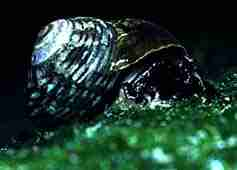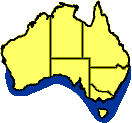|
|
Common Warrener, Turbo undulata
Form:
 The
Common Warrener is a medium to large mollusc.
Its shell is wide, round and turban-shaped. The whorls
are rounded. It has a low spire.
The sculpture consists of
low spiral ridges and deep sutures.
The early whorls are keeled
more strongly and persistent in western forms. The columella
is rounded. The aperture is
circular, covered with a thick and circular calcareous
operculum, marked on the
underside with a flat spiral.
The
Common Warrener is a medium to large mollusc.
Its shell is wide, round and turban-shaped. The whorls
are rounded. It has a low spire.
The sculpture consists of
low spiral ridges and deep sutures.
The early whorls are keeled
more strongly and persistent in western forms. The columella
is rounded. The aperture is
circular, covered with a thick and circular calcareous
operculum, marked on the
underside with a flat spiral.
Colour:
The shell is dark bluish-green, mottled with white zigzag streaks. Its surface may be covered with brown epidermis. The aperture is protected by a thick, white operculum. The umbilicus has a white callus.
Phylum: |
Mollusca |
Author: |
Lightfoot, 1786 |
Family: |
Turbinidae |
Size: |
70-110 mm diameter; length 40 mm |
Distribution:
 New
South Wales, Victoria, Tasmania, South Australia and Western Australia
to Geraldton.
New
South Wales, Victoria, Tasmania, South Australia and Western Australia
to Geraldton.
Habitat:
Found at mid to low-tide levels in rock pools and crevices on medium to high energy coasts.
Biology:
In N.S.W. this mollusc breeds from Oct./Nov. to May. The name N. whitleyi (Iredale, 1949) has been given to the strongly keeled form of W.A. However, intermediate forms occur along the southern coastline.
This mollusc grazes on algae found in the low tide levels on the shore. It is eaten by birds and fish.
The small Bonnet Limpet, Hipponyx conicus, may be found in groups attached to a Common Warrener near the opening aperture edge. It is a commensal feeder.
References:
Often referred to as Turbo undulatus and occasionally as Subninella undulatus in some references. .
Bennett, I. (1987) W.J. Dakin's classic study: Australian Seashores. p.278, Angus & Robertson, Sydney.
Davey, K. (1998) A Photographic Guide to Seashore Life of Australia. p.92, New Holland, Sydney.
Edgar, G.J. (1997) Australian Marine Life: the plants and animals of temperate waters. p.242, Reed Books, Kew.
Quinn, G.P., Wescott, G.C. & Synnot, R.N. (1992) Life on the Rocky Shores of South-Eastern Australia: an illustrated field guide. p.44, Victorian National Parks Association, Melbourne.
Marine Research Group of Victoria (1984) Coastal Invertebrates of Victoria: an atlas of selected species. p.42, Museum of Victoria, Melbourne.
Macpherson, J.H. & Gabriel, C.J. (1962) Marine Molluscs of Victoria. p.78, Melbourne University Press & The National Museum of Victoria.
Home
Page
Taxonomy
Biogeography
Rocky Shores
Tidal Levels
Intertidal Zonation
Environmental Factors
Biological
Factors
Feeding Relationships
Activities
Glossary
References
 Life
on Australian Seashores
Life
on Australian Seashores
by Keith Davey (C) 2000
Learning Consultant
- Media
The University of Newcastle
email at australian_seashores@hotmail.com
Scientific Consultant: Phil
Colman
site created 01.01.98 : updated 01.04.2000
